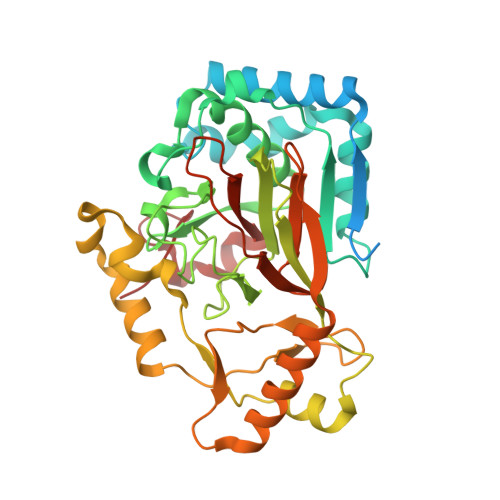Visualizing the Reaction Cycle in an Iron(II)- and 2-(Oxo)-glutarate-Dependent Hydroxylase.
Mitchell, A.J., Dunham, N.P., Martinie, R.J., Bergman, J.A., Pollock, C.J., Hu, K., Allen, B.D., Chang, W.C., Silakov, A., Bollinger, J.M., Krebs, C., Boal, A.K.(2017) J Am Chem Soc 139: 13830-13836
- PubMed: 28823155
- DOI: https://doi.org/10.1021/jacs.7b07374
- Primary Citation of Related Structures:
6ALM, 6ALN, 6ALO, 6ALP, 6ALQ, 6ALR - PubMed Abstract:
Iron(II)- and 2-(oxo)-glutarate-dependent oxygenases catalyze diverse oxidative transformations that are often initiated by abstraction of hydrogen from carbon by iron(IV)-oxo (ferryl) complexes. Control of the relative orientation of the substrate C-H and ferryl Fe-O bonds, primarily by direction of the oxo group into one of two cis-related coordination sites (termed inline and offline), may be generally important for control of the reaction outcome. Neither the ferryl complexes nor their fleeting precursors have been crystallographically characterized, hindering direct experimental validation of the offline hypothesis and elucidation of the means by which the protein might dictate an alternative oxo position. Comparison of high-resolution X-ray crystal structures of the substrate complex, an Fe(II)-peroxysuccinate ferryl precursor, and a vanadium(IV)-oxo mimic of the ferryl intermediate in the l-arginine 3-hydroxylase, VioC, reveals coordinated motions of active site residues that appear to control the intermediate geometries to determine reaction outcome.
Organizational Affiliation:
Department of Biochemistry and Molecular Biology, The Pennsylvania State University , University Park, Pennsylvania 16802, United States.

















